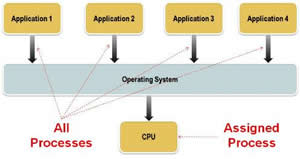Difference between Single Core and Dual Core
Key Difference: A single core processor has only one core, which means that it can only start one operation at a time. A dual-core processor is a type of a central processing unit (CPU) that has two complete execution cores. Dual core has become synonymous with Intel Pentium Dual Core.
 Computers have evolved fast from the time they were introduced. Computers were originally launched to be able to solve mathematical applications. These computers were slow to process data and could only run one operating at a time, which means another action or operation had to wait for one operation to become over, before another operation could begin. These were known as single core processors. The demand for faster technology has now created computers with dual-core, quad-core and many other cores depending on what is required from the computer.
Computers have evolved fast from the time they were introduced. Computers were originally launched to be able to solve mathematical applications. These computers were slow to process data and could only run one operating at a time, which means another action or operation had to wait for one operation to become over, before another operation could begin. These were known as single core processors. The demand for faster technology has now created computers with dual-core, quad-core and many other cores depending on what is required from the computer.
A single core refers to the number of processors that are placed in a computing system. A single core has a central processing unit (CPU) that has only one full execution core, which means that can only run one operation at a time, requiring for the first operation to finish before starting another one. A CPU is the hardware that is responsible for carrying out the instructions of a computer program.
 Single core processors can sometimes start a second application before the first one is finished, but it depends on what the application is and how much memory does it require to run. Single core processors are usually slow compared to multi-core processors as the CPU has to wait for one operation to finish before starting another; hence resulting in back of up applications for running.
Single core processors can sometimes start a second application before the first one is finished, but it depends on what the application is and how much memory does it require to run. Single core processors are usually slow compared to multi-core processors as the CPU has to wait for one operation to finish before starting another; hence resulting in back of up applications for running.
A dual-core processor is a type of a central processing unit (CPU) that has two complete execution cores. Hence, it has the combined power of two processors, their caches and the cache controllers onto a single chip. This makes the dual-core processors well-suited for multitasking.
Dual-core processors have two cores that have an independent interface to the frontside bus. Each core has its own cache. This allows the operating system to have sufficient resources to handle intensive tasks in parallel.
Image Courtesy: zone.ni.com, commons.wikimedia.org









Add new comment